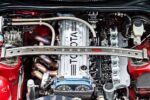Understanding Regen in Diesel Engines
When it comes to diesel engines, the term “regen” pops up quite often, and if you’re in the business of working on these machines, you better know what it means. Regen, short for regeneration, is a critical process that helps keep diesel engines running efficiently while meeting stringent emissions regulations. It’s not just some fancy tech jargon; it’s a vital operation that affects performance, fuel economy, and the overall lifespan of the engine.
Why Regen Matters
In a nutshell, regen is all about reducing harmful emissions. Diesel engines, while powerful and efficient, can produce a lot of soot and particulate matter. To combat this, modern diesel engines are equipped with Diesel Particulate Filters (DPFs) that trap these emissions. Over time, these filters can get clogged, and that’s where regen comes into play. It’s like hitting the reset button on your DPF, allowing it to burn off the accumulated soot and keep the engine running clean.
The Process of Regen
So, how does regen work? The process involves raising the temperature inside the DPF to burn off the soot. This can happen in two ways: passive and active regeneration. Passive regen occurs naturally when the engine is running at high temperatures, usually during highway driving. Active regen, on the other hand, is initiated by the engine control unit (ECU) when it detects that the DPF is getting too full. In this case, extra fuel is injected into the exhaust stream to increase the temperature and burn off the soot.
Understanding regen is essential for anyone working with diesel engines. If you neglect this process, you risk clogged filters, reduced engine performance, and even costly repairs. So, let’s dive deeper into what regen means and why it’s crucial for the health of diesel engines.
Digging Deeper into Regen in Diesel Engines
Understanding regen in diesel engines goes beyond just knowing it’s a process for cleaning up emissions. It’s a complex, critical function that plays a huge role in the performance and longevity of your engine. Let’s break it down into various aspects, so you can really grasp what regen means and why it matters.
What is Regen?
At its core, regen is a process designed to clean the Diesel Particulate Filter (DPF). The DPF captures soot and other particulate matter produced during combustion. Over time, this filter can become clogged, which can lead to a host of problems, including reduced performance and increased fuel consumption.
Types of Regeneration
Regeneration can be categorized into three types: passive, active, and forced regeneration. Each type has its own method and timing, and understanding these can help you troubleshoot issues more effectively.
| Type | Description | When It Occurs |
|---|---|---|
| Passive Regeneration | Occurs naturally when the engine reaches high temperatures, allowing soot to burn off. | During highway driving or extended periods of high RPMs. |
| Active Regeneration | Initiated by the ECU when it detects a full DPF; extra fuel is injected to raise exhaust temperature. | Typically during city driving or when the engine is idling. |
| Forced Regeneration | Manual intervention required; often performed in a shop to clear a clogged DPF. | When the DPF is severely clogged and active regen fails to occur. |
Why is Regeneration Necessary?
The need for regen stems from the environmental regulations imposed on diesel engines. With increasing scrutiny on emissions, manufacturers have developed systems to minimize the pollutants released into the atmosphere. If regen isn’t performed regularly, you can expect:
- Increased emissions, which can lead to failing emissions tests.
- Reduced fuel efficiency due to a clogged DPF.
- Potential engine damage from excessive back pressure.
Symptoms of a Failing Regen Process
When things go south with the regen process, your engine will usually let you know. Here are some signs to look out for:
- Warning Lights: Look for the check engine light or DPF warning light on your dashboard.
- Decreased Performance: Noticeable loss of power and acceleration.
- Increased Fuel Consumption: A sudden spike in how much fuel you’re burning.
- Excessive Smoke: Black smoke from the exhaust can indicate incomplete combustion.
Maintenance Tips for Effective Regeneration
Keeping your regen process running smoothly requires some proactive measures. Here are some tips to maintain your diesel engine and its DPF:
- Regularly Check Engine Codes: Use an OBD-II scanner to monitor for any trouble codes related to the DPF.
- Follow Service Intervals: Stick to the manufacturer’s recommended maintenance schedule.
- Use Quality Fuel: Low-quality fuel can lead to more soot production.
- Drive at Highway Speeds: Make sure to take your vehicle on longer drives to allow for passive regen.
Conclusion
Understanding regen in diesel engines is crucial for anyone working with or owning these vehicles. It’s not just a technical detail; it’s a fundamental process that keeps the engine running efficiently and cleanly. By knowing the types of regen, the necessity behind it, and how to maintain it, you can ensure that your diesel engine remains in top condition, ready to tackle whatever you throw at it.




0 Comments